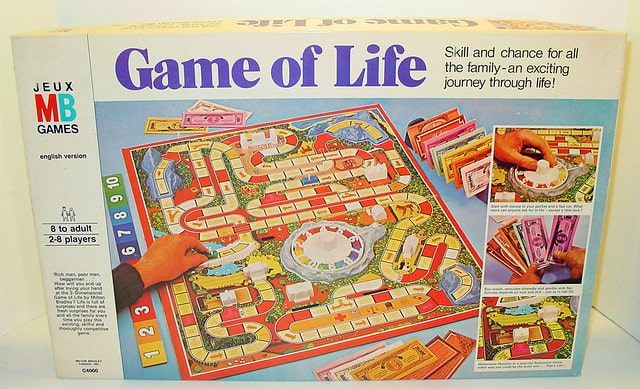The Game of Life is a board game that attempts to mimic life and its many aspects and nuances and present it in a fun way. Life is too short to worry too much, so might as well play a game revolving around it.
Overview
Simply known as Life, the game was originally created by Milton Bradley in 1860. He called it the Checkered Game of Life which quickly became the first most popular parlor game in America.
This is mainly to do with the fact that a person can stimulate through their life using the board game. From college to retirement and everything else in between, a player can play the game of life.
The modern version of the original game was published in 1960, a century later. Game designer Reuben Klamer created and co-designed the latest version.
Gameplay and preparation
The game can be played by two to six players. It is suitable for children 9 years old and above and adults.
The object of the game is to travel to the different paths of life making different decisions, from earning money and building a family. A player collects LIFE tiles throughout the game.
Whoever has the highest value at the end is declared the winner.
The game has different components, including 25 LIFE tiles and 1 deck of cards. Each LIFE tile is equivalent to a dollar amount that is counted towards the total cash value of a player at the end of the game.
At every start:
- All LIFE tiles are shuffled and placed life-side-up near the board game.
- All cards are separated into a career, house deeds, salary, and stocks.
- One of the players must be chosen as a banker who will give each player 10,000 dollars.
- Each player must choose a specific car color and then place it on the designated starting space.
- Each player must first decide if they want to go to college or start a career. Each option comes with specific game preparation procedures to go through.
Once that’s decided, only then the game begins.
Game rules
All players must spin the spinner to decide who takes the first turn. Whoever gets the highest spin gets to play first.
Play will then continue in a clockwise direction.
A player must spin the spinner in every turn. If the needle stops between numbers, a player gets the spin again.
To move through the game board, a player’s car will be moved according to the number of spaces spun.
A car must be moved forward in the direction of the arrows. If a tile is occupied, skip and move to the next empty one.
At every first turn, a player gets to set in motion the plan they made pre-game—start college or start a career.
Start college
- A player must first place their car on the START COLLEGE space to signal the start of their game in life.
- Then, they must borrow money for tuition from the bank worth $100,000.
- A player then spins and moves their car as they would on a regular turn.
Start a career
- A player must randomly draw a career card from a deck that is spread out face down
- The career card is then placed face up in front of a player. They must then spin the spinner and move their car on a regular turn.
Each space on the game board has specific directions that a player must follow. Some of them are good, some of them aren’t.
A few examples are:
- Collect/pay spaces indicate whether a player needs to collect from or pay money to the bank the amount specified.
- Life spaces allow a player to draw a LIFE tile from the pile and place it life-side-up in front of them. When all the pile has been drawn out, a player can take one LIFE tile from any of their opponents.
- End up at the ‘Lose your Job’ space and a player must trade in their starting card–a Career or College card for a new one.
The game ends when all players have retired. Each one must then add their total value based on the cash and LIFE tiles (worth a dollar amount each) accumulated. Whoever gets the highest total value wins.
